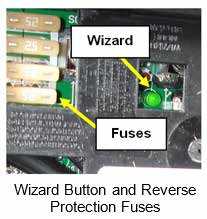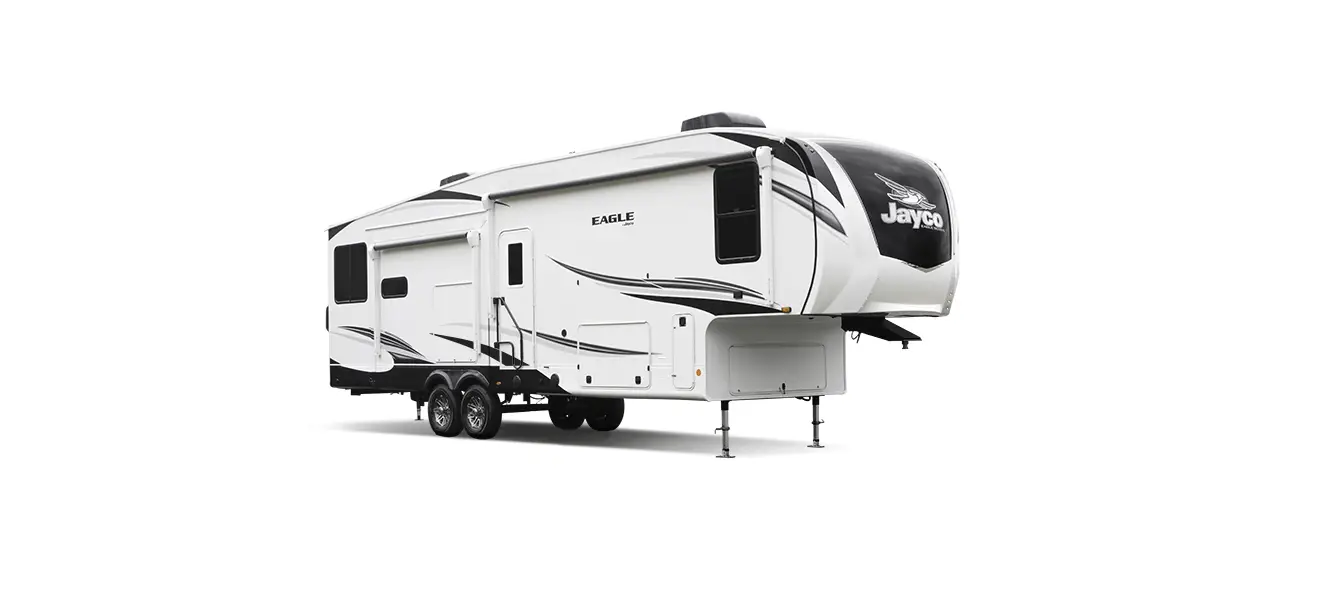 2023 Jayco Eagle Fifth Wheels Power Converter Instruction
2023 Jayco Eagle Fifth Wheels Power Converter Instruction
The power converter in the 2023 Jayco Eagle Fifth Wheels is an important part of modern RV living. It combines ease of use and functionality in a way that makes it an efficient and reliable way to handle power. The power converter was made to connect external AC power sources to the internal DC electrical system. It acts as a key link, allowing 120V AC power from shore lines or generators to be changed into the needed 12V DC power. This converted energy is important not only for charging the batteries on board, but also for providing the current needed to power the RV’s DC appliances, lights, and entertainment systems. As a key part of the RV’s electrical system, the power converter shows Jayco’s commitment to improving the camping experience as a whole by making sure there is a steady supply of power and letting travelers enjoy all the comforts and conveniences of home while on the road. With its smart design and reliable operation, the power converter is an important ally that allows travelers to set out on their journeys with the peace of mind that their mobile home is well-equipped and running well.
Power Converter
The power converter converts 120-volt AC power to usable 12-volt DC power when the shore power cord is connected to an external power source.
The converter has a built-in protective thermal breaker that will shut it down should overheating occur. Overheating can be caused by operating the converter above its maximum power output for an extended period of time, or by an obstruction to its ventilation airflow. To reduce converter heat build keep unnecessary 12-volt lights and motors turned off. Keep the converter cooling fins and fan clear of obstructions.
- USE ONLY A DEEP-CYCLE BATTERY FOR RV USE. Car batteries (CCA rating) are not designed for RV applications.
- If using multiple batteries they must be the same brand and type. Adding more batteries will provide longer use of DC appliances when not on shore power but may reduce charging efficiency.
- The battery works in conjunction with the converter to supply DC power to the RV. A battery is typically only necessary if you do a lot of dry camping or have slide-outs and/or a leveling system.
- A reverse polarity fuse provides protection for the converter when a battery is used. If the battery is connected back to the fuse board this fuse would blow pre-venting damage to the converter.
- Dimming or flickering lights usually indicates an overloaded converter. Remove some of the load by turning off DC lights or appliances.
- Fan is controlled by load. It will begin running at 3 to 6 amp DC draw. It increases in speed with a higher load until 14 to 15 amps. The fan is at maximum speed and stays there even with more load. If the load drops below 6 amps DC, the fan shuts off.
CAUTION
It is important that the fluid level of any connected batteries be checked on a regular basis. All batteries will “gas” and lose some fluid when continuously connected to any charging source (does not apply to “gel-cell” batteries). Before checking for converter output voltage, the battery cables must be disconnected at the battery. Make sure the converter is plugged into an AC source (105-132 AC volts). Check the converter output voltage at the battery with a voltmeter. Place the voltmeter probes on the disconnected battery cables. If the voltage reads 13.6VDC with no load, the converter is functioning properly. If the converter output voltage at the battery reads in the 0.0VDC range, or the battery is not charging, check for:
- An open inline fuse in the battery wire
- An open wire between the converter and the RV battery
- Loose ground connection
- Improper torques
If the converter fuses and AC voltage are good, but the converter output still reads zero volts, the converter is not functioning properly.
Modes of Operation
Absorption (Normal) Mode: 13.6VDC range. Batteries are being charged, just at a slower rate. The converter will not work without AC input.
Float Trickle Mode: To get your converter into this mode, reduce the load on the system to almost nothing but the battery. Let the system sit for approximately 44 hours.
The converter voltage will drop to 13.2VDC. If the converter sees any load during this period or after it is in Float Mode it will revert back to Absorption (Normal) Mode. 13.6VDC.
Bulk Mode: The converter will not jump into the Bulk Mode unless the battery is below 50% of charge, or approximately below 13.2VDC output voltage. There is no way to force it to go into Bulk Mode. Red LED indicates a blown fuse.
Inspection and maintenance
If the 12-volt power converter is not working (auxiliary battery not being charged) check the reverse polarity fuse(s) located on the end of the converter.
There are no customer-serviceable parts inside the converter case and the manufacturer’s warranty will be void if the case has been removed. If you have further concerns contact your dealer. For detailed safety and operating information, refer to the manufacturer’s owner’s manual.
Converter w/Charge Wizard (if so equipped)
Some converters may be equipped with a charge wizard There are (3) possible charging modes; NORMAL, BOOST, and STORAGE. The charge wizard will automatically select the best mode to charge your battery. A green LED next to the wizard mode button will indicate by flashes, which mode is currently being used.
Normal Mode: Green LED flashes once per second; battery is between 50% and 90% charged. flashes 2-3 times per second; the battery is 90% charged. Output voltage is 13.6VDC and the converter is safely completing the charge of the battery.
Boost Mode: Green LED is on solid. The output voltage is 14.4VDC to rapidly charge the battery up to 90% of full charge.
Storage Mode: Green LED flashes every 6-8 seconds. The output voltage has been reduced to 13.2VDC; the RV battery is fully charged and converter is maintaining the charge.
Manual Mode (not recommended): The manual mode button is used to override the charge wizard. Refer to the converter owner’s manual for additional information.
Reverse Battery Protection:
Reverse polarity fuse(s) provide protection for the converter when a battery is used. If the battery is connected backwards to the fuse board a fuse will blow preventing damage to the converter. Four easily accessible fuses are located next to the wizard button. Replace with fuses of the same type and rating.
12-Volt DC System. The majority of your recreation vehicle lighting is powered by 12-volt electricity. The 12-volt DC system is composed of components that will operate when the following conditions are met:
- Power is supplied by the tow vehicle alternator when the engine is running and the
7- way the trailer plug is connected. This powers the RV’s running lights, brake lights, turn signals and brakes. In addition, the 7-way trailer plug provides a common ground and a 12-volt charge line to charge the auxiliary battery. - The converter will supply interior 12-volt DC power when the power cord is plugged into campground power. The converter will also charge the RV battery in most situations. (Refer to Battery Disconnect)
- The auxiliary battery powers many interior 12-volt components including the lighting fixtures, water pump, 12-volt motors, 12-volt appliances, etc. It also powers the breakaway switch.
12-Volt Fuse Panel
WARNING
Replacement fuses must be of the same voltage, amperage rating, and type. Never use a higher-rated replacement fuse; doing so may cause a fire by overheating the RV wiring.
The 12-volt fuse panel is labeled to indicate fuse sizes, positions, and the components powered. Fuses are located in the load center.
Replacing a Fuse
Before replacing a fuse, always turn off the electrical components protected by it.
- Disconnect the shore power cord.
- Turn “off” the inverter (if so equipped).
- Disconnect the house or auxiliary batteries main negative battery cable.
- Remove the fuse panel cover to check fuses.
- Pull the fuse straight out of the fuse block.
- Insert a new fuse of the same specified voltage, amperage rating and type in the original location.
The fuse panel label should be kept permanently affixed to your recreation vehicle. Fuses will not offer complete protection of the electrical system in the event of a power surge or spike.
12-Volt DC Outlet
There may be one or more 12-volt DC power outlets in your recreation vehicle. When the 12-volt DC outlet is used as a power source for an electric appliance, make sure the appliance operates on 12-volt DC power and that it consumes less than 60 watts (5 amps) of power.
WARNING
Keep the protective dust cap on the 12-volt DC outlet when not in use to prevent ingestion of foreign material and potentially short circuit conditions.
FAQ
A: The power converter is responsible for converting the incoming AC power (from shore power or generator) into DC power to charge the RV’s batteries and power the DC electrical system.
A: The power converter uses transformers and electronic components to convert 120V AC power to 12V DC power, which is essential for running lights, appliances, and charging batteries.
A: The power converter can accept 120V AC power from external sources such as shore power or a generator.
A: The power converter primarily operates when connected to an AC power source. When boondocking, you might rely on your RV’s batteries and potentially a solar panel setup for power.
A: Many modern power converters are compatible with both battery types, but it’s important to check the specifications to ensure compatibility.
A: The charging rate can vary based on the model and specifications. Some power converters offer multiple charging modes for efficient battery charging.
A: Some power converters have built-in features to prevent overcharging and protect batteries from damage.
A: Yes, power converters can often be upgraded or replaced to accommodate changing power needs or to enhance efficiency.
A: Generally, power converters require minimal maintenance beyond ensuring proper ventilation and keeping the area around them clean.
A: Yes, it’s possible to integrate a power converter with a solar charging system to provide a comprehensive power solution.
A: Many modern power converters are designed to operate quietly, but some may emit a low hum during operation.
A: Different Jayco models might come with various power converter options to suit different needs and preferences.
A: If the power converter malfunctions, it might result in issues with charging batteries or powering DC systems. Professional diagnosis and repair might be necessary.
A: The power converter’s primary role is to charge batteries, but the 12V DC power it generates can also be used to power appliances and lights directly.
A: You can refer to the Jayco Eagle Fifth Wheels 2023 owner’s manual or consult with Jayco dealerships for detailed information about the power converter and its features.
Useful Link
View Full User Guide: Jayco Eagle Fifth Wheels 2023 User Manual
Jayco Eagle Fifth Wheels 2023 Monitor Panel User Manual

